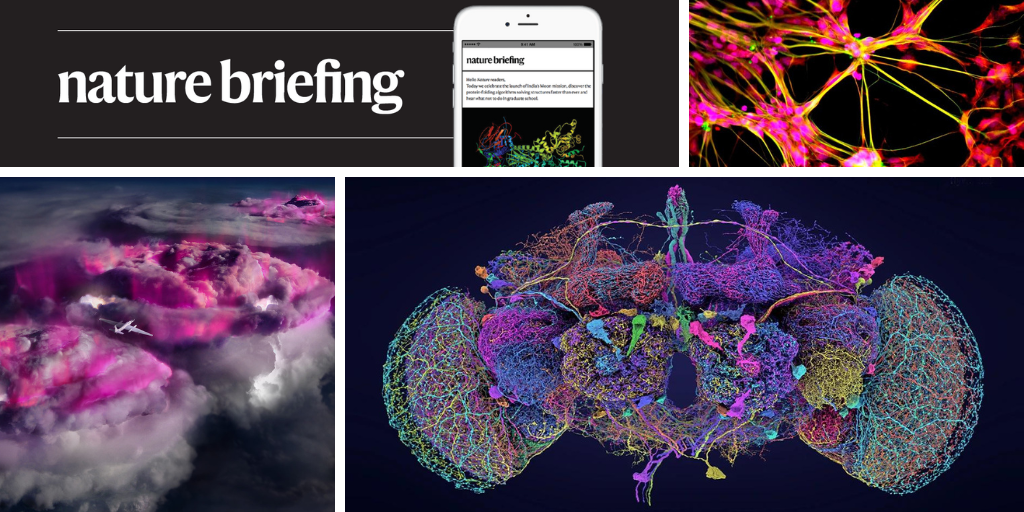Hello Nature readers, would you like to get this Briefing in your inbox free every day? Sign up here.

Illustration of an aircraft flying above thunderclouds to monitor gamma-ray glows, coloured in purple.Credit: The ALOFT team/Mount Visual (CC BY 4.0)
Physicists have discovered a new form of γ-ray radiation that emerges from tropical thunderstorms. ‘Gamma’ radiation is usually associated with extreme cosmic environments, such as black holes, but observations show that the invisible bursts of energy are more common on Earth than previously thought. Understanding the source of the radiation could help scientists to shed light on the centuries-old question of what initiates lightning. Physicists made the discovery by flying a high-altitude ex-cold-war spy plane, converted by NASA, as close as 1.5 kilometres above storms in Central America and the Caribbean.
Reference: Nature paper 1 & paper 2
Reducing the activity of one particular gene in ageing mice rejuvenates brain stem cells, allowing them to proliferate and provide a supply of fresh neurons. Researchers used CRISPR-Cas9 genome editing to systematically disrupt 23,000 genes and test the effects on neural stem cells. Messing with one such gene, Slc2a4, reduced stem cells’ glucose intake and increased their power to proliferate in old animals, but didn’t affect the cells in young mice. The results provide crucial information for the design of cell therapies that might one day treat neurodegenerative conditions, says neuroscientist Saul Villeda.
Fungal soil microbes that promote plant growth seem to get a boost from white noise. When scientists periodically played a noise similar to radio static to Trichoderma harzianum, the fungi grew bigger and produced more spores than other samples grown in a soundproof booth. The vibrations might stimulate mechanoreceptors in Trichoderma’s cell walls, which alters the expression of genes involved in growth, suggest researchers.
Reference: Biology Letters paper
Features & opinion
There’s no surefire way to win a Nobel Prize, but Nature crunched the data to work out which characteristics can be reliably linked to medals. (Spoilers: if you’re a 54-year old man who produced award-worthy work around 20 years ago, listen out for your phone ringing next week!)
Biologist Rachel Carson’s 1962 book Silent Spring changed how the world thought about chemicals and human health for the better. But Carson’s implication that chemicals are ‘poisons’ paved the way for ‘chemophobia’, argues journalist Katie MacBride: a fear that can snowball into an overall mistrust of conventional science. “Many believe synthetic or manufactured chemicals are inherently harmful,” says medical toxicologist Ryan Marino. “When in reality, nature is trying to kill us all the time.”
Today I’m practising my puppy-dog eyes after learning that coyotes are also capable of the heart-melting expression that draws us to our domestic canine friends. Unfortunately for me, it relies on a special muscle humans don’t have: the levator anguli oculi medialis.
Let us know what look this newsletter brought to your face at [email protected].
Thanks for reading,
Jacob Smith, associate editor, Nature Briefing
With contributions by Flora Graham
Want more? Sign up to our other free Nature Briefing newsletters:
• Nature Briefing: Careers — insights, advice and award-winning journalism to help you optimize your working life
• Nature Briefing: Microbiology — the most abundant living entities on our planet — microorganisms — and the role they play in health, the environment and food systems.
• Nature Briefing: Anthropocene — climate change, biodiversity, sustainability and geoengineering
• Nature Briefing: AI & Robotics — 100% written by humans, of course
• Nature Briefing: Cancer — a weekly newsletter written with cancer researchers in mind
• Nature Briefing: Translational Research — covers biotechnology, drug discovery and pharma


